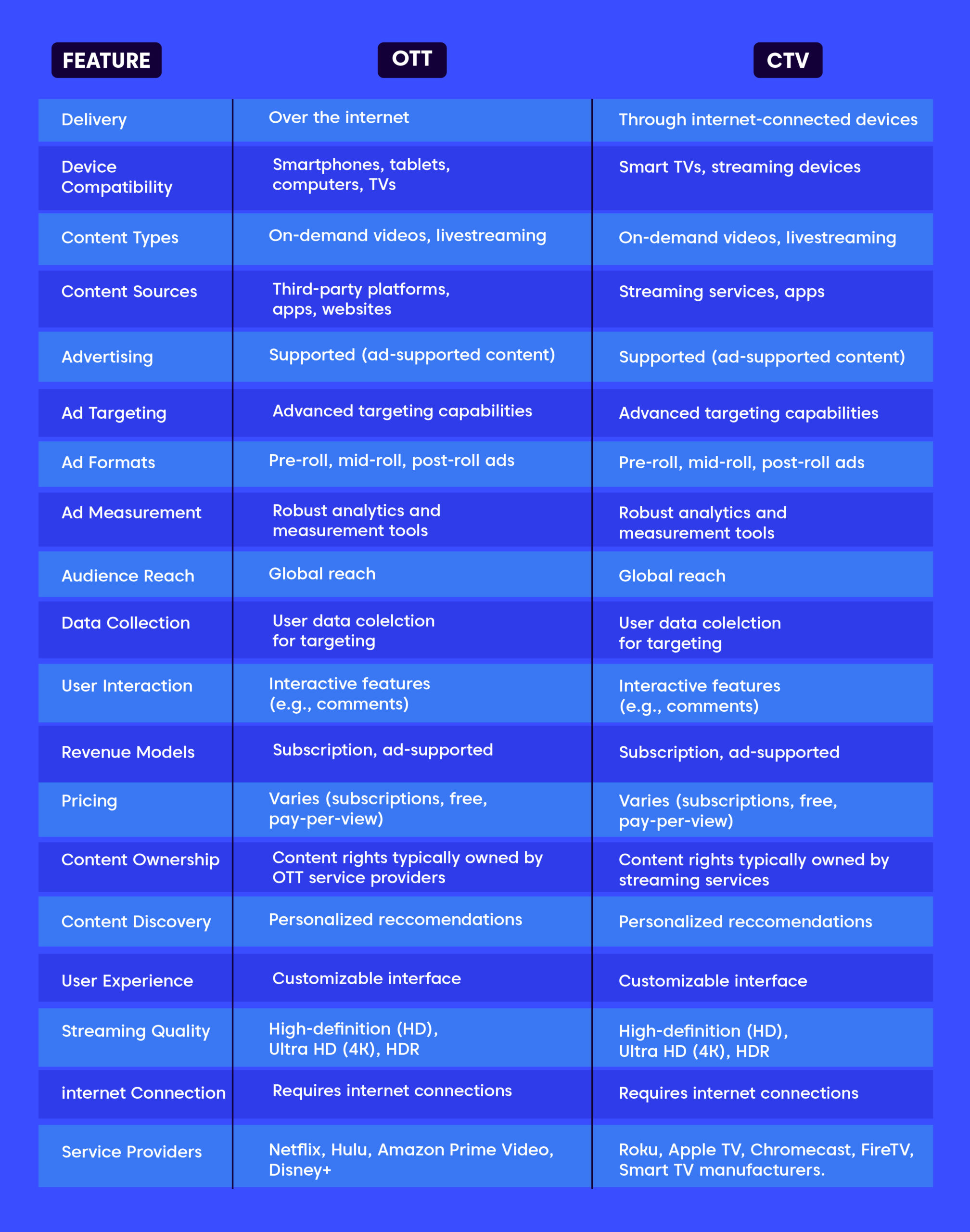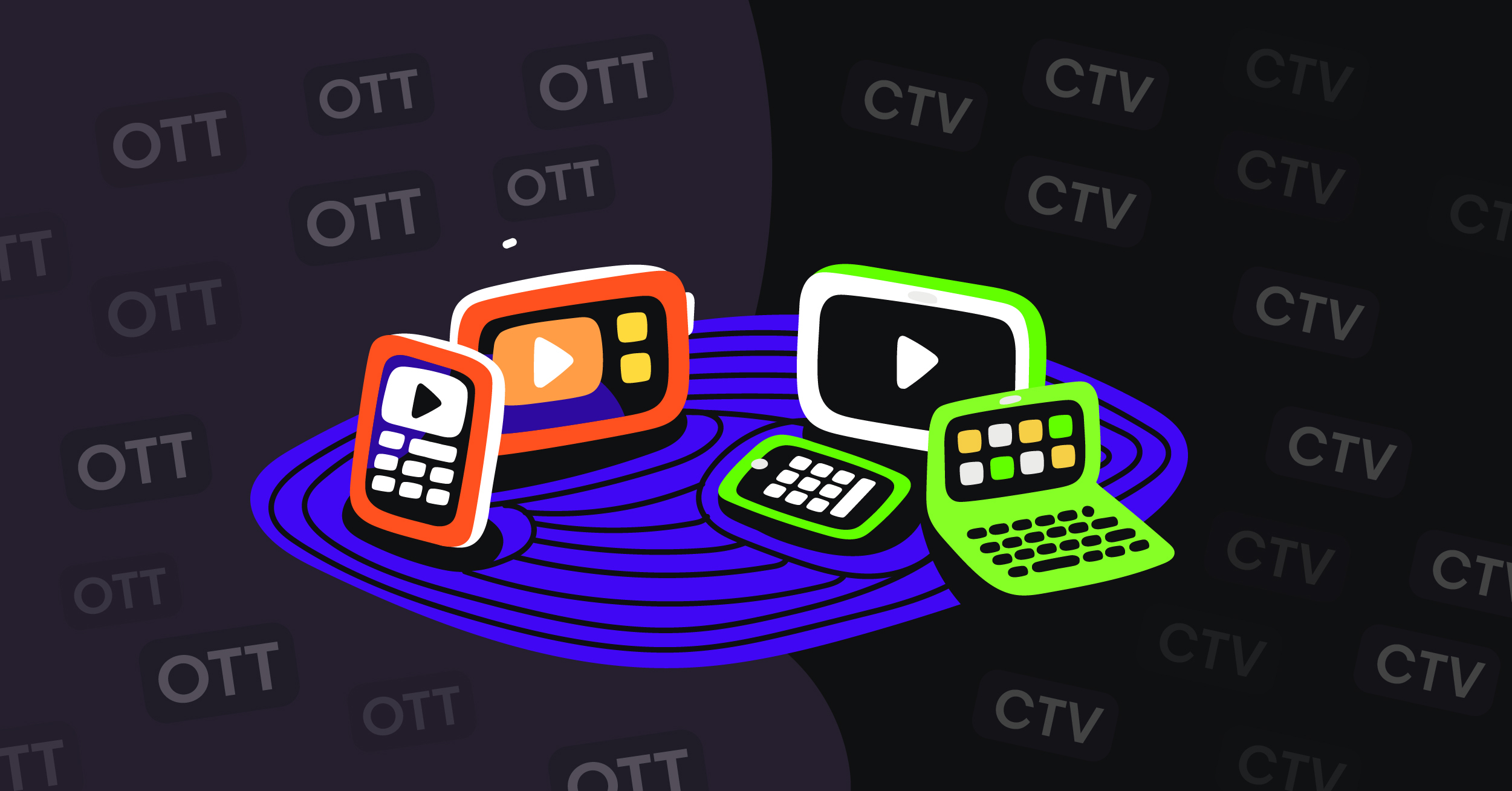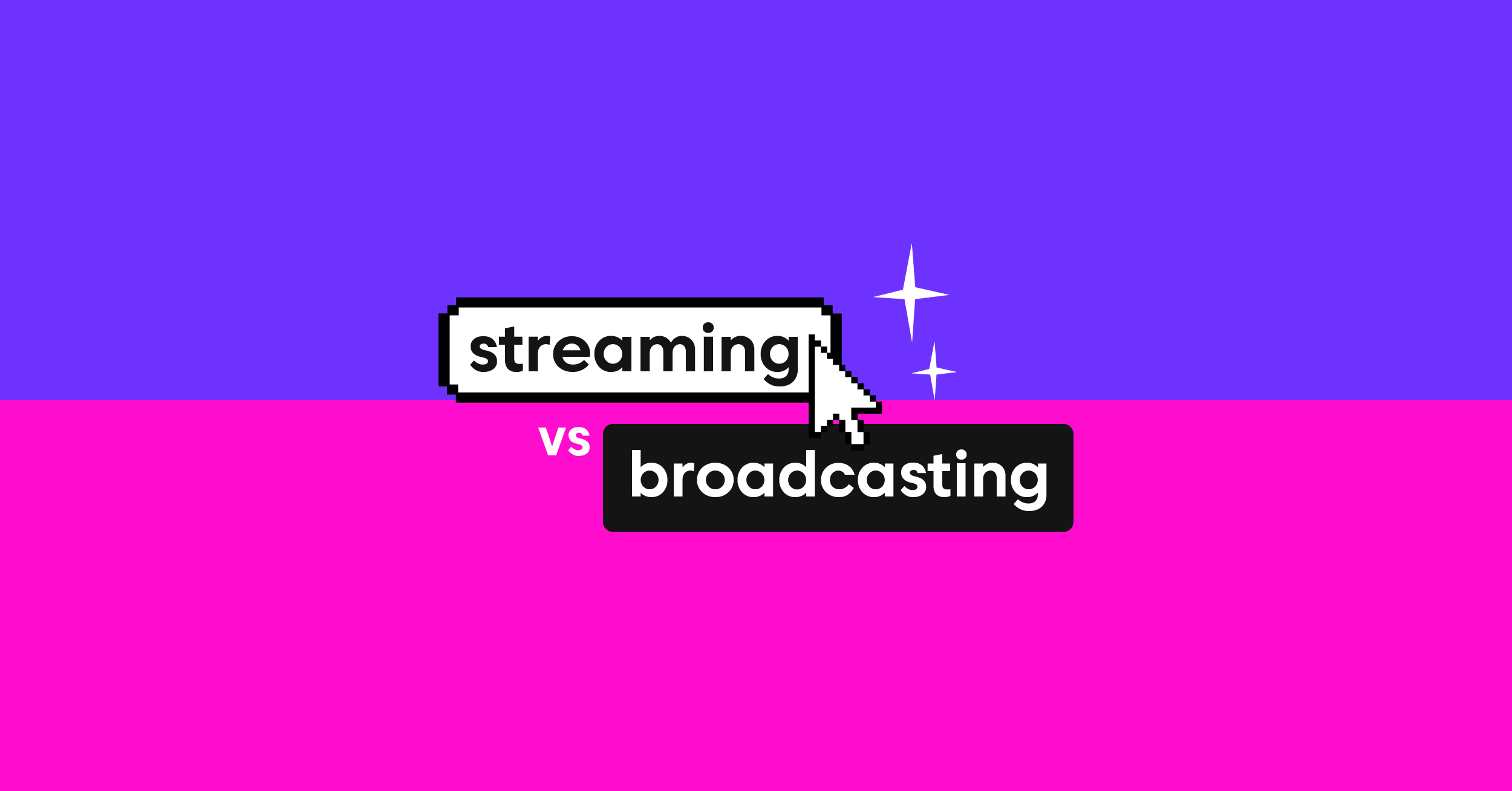In the area of digital advertising, the difference between OTT (Over-the-Top) and CTV (Connected TV) has gained a lot of attention. Understanding the nuances between the two terms is essential for marketers, given the growing popularity of streaming services and internet-connected devices.
In this article, we will explore the disparities between OTT and CTV in simple terms and shed light on how they impact advertising strategies.
OTT and CTV are often used interchangeably, but they have distinct differences. OTT refers to any content delivered over the Internet without requiring a traditional cable or satellite subscription. This can include streaming services like Netflix, Amazon Prime Video, and Hulu, which are accessible through various devices such as smart TVs, streaming devices (e.g., Amazon Fire TV, Apple TV), gaming consoles (e.g., Nintendo Switch), and mobile devices. Contrarily, CTV refers particularly to a television set that has internet access so that consumers can stream OTT material right to their TV screens. CTV devices include smart TVs (e.g., Samsung Smart TV), streaming devices (e.g., Amazon Fire Stick), and gaming consoles. CTV has gained immense popularity, attracting cord-cutters who opt for streaming services over traditional cable or satellite TV.
When it comes to advertising, both OTT and CTV provide unique opportunities to reach viewers in a targeted manner. OTT and CTV advertising allow brands to deliver ads during streaming video content, targeting specific audiences based on their interests and demographics. Advertisers can optimize campaigns to ensure brand safety and high video completion rates.
OTT advertising extends beyond CTV devices, reaching viewers on any internet-connected device. It allows ads to run on mobile phones, tablets, and computers, broadening the reach of campaigns. CTV advertising, on the other hand, is limited to streaming on television screens. However, CTV ads offer larger, more immersive viewing experiences for the audience.
In terms of content delivery, OTT platforms typically offer a wide range of video content, including movies, TV shows, and original programming. CTV, being a subset of OTT, focuses exclusively on streaming video content on television sets. This distinction is essential for advertisers to understand as it helps tailor their strategies for each platform accordingly.
In summary, while OTT and CTV are related, they have distinct characteristics. OTT encompasses a broader scope of content delivery on various devices, while CTV specifically pertains to streaming on television screens. Both OTT and CTV advertising provide unique advantages for marketers looking to engage with their target audience effectively. By understanding the difference between these two terms, advertisers can optimize their campaigns and deliver compelling ads to viewers across connected devices and television sets.
OTT vs. CTV: Comparison Table
Below is a comparison table highlighting the key features and differences between OTT (Over-the-Top) and CTV (Connected TV):

Please note that this table provides a general overview, and there may be variations and additional features depending on specific platforms and services within the OTT and CTV space.
What is OTT?
What is OTT? In simple terms, OTT, which stands for “Over-the-Top,” refers to the delivery of video content over the Internet, bypassing traditional linear TV channels that require a cable or satellite subscription.
OTT services enable viewers to stream OTT content on various devices such as smart TVs, streaming devices (e.g., Apple TV, Amazon Fire TV), gaming consoles (like Nintendo Switch), and mobile phones. Connected TV (CTV) is a related term often used interchangeably with OTT. CTV devices, including smart TVs and streaming devices, allow users to access streaming services and watch video content on their television sets equipped with internet connectivity.
OTT and CTV advertising has gained prominence due to the increasing popularity of streaming services and the shift in viewership from traditional television to OTT and CTV platforms. Advertisers can now target their desired audience by delivering ads through OTT and CTV platforms, optimizing campaigns, ensuring brand safety, and tracking metrics such as video completion rate and ad exposure.
How OTT Works: A Simplified Explanation of Over-The-Top Streaming
Wondering how OTT works? Over-The-Top (OTT) streaming has transformed the way we consume media, offering convenient access to a vast array of content. OTT bypasses traditional distribution channels, enabling viewers to stream their favorite shows, movies, and more directly over the internet. So, how does it work?
OTT operates through a few essential components. First, there’s the content provider, which could be a major streaming service like Netflix, Amazon Prime Video, or Hulu. These providers curate and produce a wide range of content to cater to diverse viewer preferences.
Next, there’s the content delivery network (CDN). CDNs play a crucial role in OTT by storing and distributing the content efficiently. When you hit that “play” button, the CDN ensures that the video or audio data reaches your device smoothly, reducing buffering and latency issues.
Finally, we have the user’s device, whether it’s a smart TV, smartphone, or tablet. The content is streamed directly to your device via an app or a web browser, allowing you to enjoy your favorite shows on-demand, whenever and wherever you want.
To sum up, OTT works by connecting content providers, content delivery networks, and user devices to deliver a seamless streaming experience. Embracing this technology has revolutionized the way we consume entertainment, offering convenience and flexibility like never before.
The Benefits of the OTT
The Benefits of the OTT are numerous. Firstly, OTT enables you to access a vast array of content on-demand, anytime, and anywhere, providing unparalleled convenience. Without a cable or satellite subscription, you can stream movies, TV shows, and music to your preferred device using OTT.
Furthermore, OTT offers a personalized viewing experience, allowing you to customize your content preferences and recommendations. Additionally, because you only pay for the particular services you want, it helps foster cost-effectiveness. Embrace the Benefits of the OTT and revolutionize your entertainment experience (unlocking a world of entertainment possibilities).
The Disadvantages of OTT
While OTT offers convenience and access to a vast range of content, there are notable disadvantages to consider. Firstly, excessive reliance on streaming can strain internet bandwidth, resulting in slower connections and increased data usage. Secondly, the subscription costs for multiple OTT platforms can quickly add up, potentially straining your budget.
Moreover, the lack of live programming on OTT services may be a drawback for those seeking real-time events like sports or news. Lastly, some users may experience content fragmentation, with their favorite shows and movies spread across various platforms, making it challenging to access all desired content in one place. Understanding the disadvantages of OTT is essential for making informed decisions about entertainment options.
What is CTV?
What is CTV? Instead of using traditional cable or satellite subscriptions to contact viewers, CTV, or connected TV, is a fast-growing type of digital advertising.
To provide video content straight to the TV screen, CTV makes use of smart TVs, streaming devices like Apple TV, gaming consoles like the Nintendo Switch, and other internet-connected devices. Unlike traditional linear TV, CTV offers a more targeted and measurable approach to advertising. With CTV advertising, brands can optimize campaigns to reach their target audience on various devices, ensuring ad exposure across a wide range of connected devices.
OTT (Over-the-Top) and CTV advertising are closely related, as both OTT and CTV refer to the delivery of video content over the Internet without the need for a cable box or satellite provider. OTT platforms, such as Amazon Prime Video and Netflix, stream OTT content to users’ devices, including mobile phones, smart TVs, and tablets. CTV, on the other hand, specifically focuses on delivering video content to television sets equipped with internet connectivity.
CTV advertising offers numerous advantages over traditional television advertising. It provides better brand safety controls, as advertisers can ensure their ads are shown in appropriate environments. CTV also allows for more precise targeting and measurement capabilities, enabling advertisers to optimize campaigns and reach viewers who are cord-cutters or have shifted their TV consumption to streaming services. Additionally, CTV offers higher engagement rates, with viewers exhibiting higher video completion rates compared to traditional TV ads.
In summary, CTV is a powerful advertising medium that leverages internet connectivity and streaming devices to deliver targeted video content directly to viewers’ TVs. Compared to traditional television advertising methods, it gives advertisers the chance to optimize campaigns, reach a wider audience, and increase engagement rates. By embracing CTV and its associated advertising opportunities, businesses can effectively connect with their target audience in today’s digital age.
How CTV Works
Are you wondering how CTV works? A prevalent way of streaming television shows over the internet is CTV or connected TV. Smart TVs or accessories like Roku, Apple TV, or Amazon Fire TV are required in order to access streaming services.
So, how does CTV work? A connection is established with the streaming service’s server when you launch a streaming app on your CTV device when it is online. The server then sends video content in the form of data packets to your device. These packets are decoded by your CTV device and transformed into high-quality video and audio. This process ensures smooth streaming and an enjoyable viewing experience. CTV works by leveraging internet connectivity to provide on-demand access to a wide range of TV shows, movies, and other content.
CTV is growing in popularity as technology progresses since it enables people to watch their preferred shows whenever it’s convenient for them. Now you know how CTV works and can enjoy seamless streaming on your CTV device! them. Now you know how CTV works and can enjoy seamless streaming on your CTV device!
The Benefits of CTV
The Benefits of CTV are immense and can greatly impact your digital advertising strategy. It offers a host of benefits that traditional TV advertising cannot match.
Firstly, CTV provides precise targeting capabilities, enabling you to reach your desired audience with pinpoint accuracy. This translates into higher engagement and conversion rates for your campaigns. Secondly, CTV allows for interactive and personalized ad experiences, fostering stronger connections with viewers. With CTV, you can gather valuable data and insights on viewer behavior, enabling you to refine and optimize your campaigns for better results. Additionally, CTV offers cost-effective advertising options compared to traditional TV, making it a budget-friendly choice for businesses of all sizes.
In summary, The Benefits of CTV encompass precise targeting, interactive experiences, data-driven insights, and cost efficiency, making it a game-changer in the world of digital advertising.
The Disadvantages of CTV
Despite its numerous advantages, CTV does present a few challenges. Firstly, one significant disadvantage is the limited ad targeting options. Unlike traditional television, CTV lacks precise targeting capabilities, which can result in irrelevant ads being shown to viewers. Another downside of CTV is ad fraud. Since CTV platforms rely heavily on programmatic advertising, there is a higher risk of fraudulent activities, such as bot traffic and ad stacking. This not only wastes advertising budgets but also undermines the effectiveness of campaigns.
Additionally, measurement and attribution can be problematic for CTV, making it difficult to track and evaluate the success of advertising efforts accurately. Lastly, ad blocking poses a challenge in the CTV space. As viewers become more tech-savvy, they may employ ad-blocking software or devices, preventing ads from being displayed altogether.
Despite its popularity, it’s crucial to be aware of these disadvantages when considering CTV as part of your advertising strategy.
The Bottom Line (OTT vs. CTV: What is the difference?)
It’s crucial to grasp the difference between OTT and CTV because both terms refer to streaming video over the Internet, but they have distinct characteristics.
Any streaming service that offers video content directly to consumers via the internet, bypassing traditional cable or satellite providers, is referred to as OTT. CTV, on the other hand, refers to televisions or devices that are internet-connected and capable of streaming content. The main distinction lies in the devices used for accessing content. While OTT includes platforms such as smartphones, tablets, and laptops, CTV focuses on TVs and streaming devices such as smart TVs, Roku, Apple TV, and Chromecast.
Understanding this difference is crucial for marketers and advertisers to effectively reach their target audiences. By optimizing content for both OTT and CTV, businesses can enhance their visibility and engagement across different streaming platforms, catering to the preferences and habits of modern viewers.









